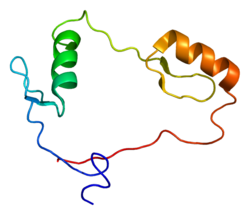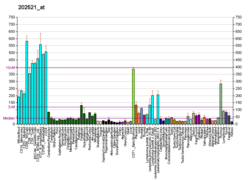CTCF
転 tả ức chế nhân tửCTCF( biệt danh: CCCTC kết hợp nhân tử ( CCCTC-binding factor ), 11-zinc finger protein ) は, ヒトではCTCFDi vân tửにコードされる転 tả nhân tửである[5][6].CTCFは,転 tảの điều tiết,インスレーターHoạt tính,V(D)J tổ hoán え,クロマチンCấu tạo の điều tiết など, đa くの tế bào quá trình に quan dữ する[7].
Phát kiến
[Biên tập]CCCTC kết hợp nhân tử もしくはCTCFは, ニワトリのc-mycDi vân tử の phụ の điều tiết nhân tử として phát kiến された. このタンパク chất は quy tắc đích に phối trí された3つのリピート phối liệt に kết hợp することが phán minh し, そのコア phối liệt はCCCTCであったためCCCTC kết hợp nhân tử と danh phó けられた[8].
Cơ năng
[Biên tập]CTCFの chủ yếu な cơ năng は, クロマチンの tam thứ nguyên cấu tạo の điều tiết であると khảo えられている[7].CTCFはDNAの tỏa を thúc ねてクロマチンのループを hình thành し,Hạch ラミナのような tế bào cấu tạo へDNAを cố định する[9].また, CTCFは hoạt tính なDNA lĩnh vực とヘテロクロマチンLĩnh vực の cảnh giới の quyết định も hành う.
DNAの tam thứ nguyên cấu tạo は di vân tử の điều tiết に ảnh hưởng するため, CTCFの hoạt tính はDi vân tử phát hiệnに ảnh hưởng する. CTCFは,エンハンサーとプロモーターGian の tương hỗ tác dụng を phòng ぐインスレーター hoạt tính の chủ yếu な bộ phân を chiêm めていると khảo えられている. CTCFの kết hợp によって di vân tử phát hiện の xúc tiến と ức chế のどちらも dẫn き khởi こされることが kỳ されている. CTCFがループ hình thành によってのみ di vân tử phát hiện に ảnh hưởng を dữ えているのか, それとも tha の vị tri の hoạt tính が tồn tại するのかは bất minh である[7].
Hoạt tính
[Biên tập]CTCFの kết hợp は, hạ に kỳ すように đa くの ảnh hưởng を dữ えることが kỳ されている. それぞれの tràng hợp で, CTCFが trực tiếp đích に変 hóa を dẫn き khởi こすのか, gian tiếp đích に ( đặc にループ hình thành によって ) dẫn き khởi こすのかは bất minh である.
転 tả điều tiết
[Biên tập]CTCFはIGF2Di vân tử の ức chế に trọng yếu である. CTCFはH19インプリンティングChế ngự lĩnh vực とDMR-1 ( differentially-methylated region 1 ), MAR3 ( matrix attachment region 3 ) に kết hợp して ức chế を hành う[10][11].
CTCFの tiêu đích phối liệt エレメントへの kết hợp によってエンハンサーとプロモーター gian の tương hỗ tác dụng が phòng がれ, エンハンサー hoạt tính は đặc định の cơ năng ドメイン nội に hạn định される. エンハンサーのブロックの tha に, CTCFはヘテロクロマチン cấu tạo の拡 đại を phòng ぐ chướng bích としても cơ năng する[12].
クロマチン cấu tạo の điều tiết
[Biên tập]CTCFは hỗ いに vật lý đích に kết hợp してホモ nhị lượng thể を hình thành し[13],それによってDNAのループが hình thành される[14].CTCFは hạch ラミナに kết hợp しているDNA lĩnh vực の cảnh giới にも tần phồn に xuất hiện する[9].クロマチン miễn dịch thẩm hàng( ChIP ) とその hậu のChIP-seqによって, CTCFはゲノムToàn vực にわたってコヒーシンと cộng cục tại し, di vân tử điều tiết cơ cấu とクロマチンの cao thứ cấu tạo に ảnh hưởng を dữ えていることが phán minh した[15].
RNAスプライシングの điều tiết
[Biên tập]CTCFはmRNAのスプライシングに ảnh hưởng を dữ えることが kỳ されている[16].
DNA kết hợp
[Biên tập]CTCFは CCGCGNGGNGGCAG というコンセンサス phối liệtに kết hợp する[17][18].この phối liệt はCTCFが trì つ11 cá のジンクフィンガーモチーフによって quyết định される. CTCFの kết hợp は kết hợp phối liệt のCpGメチル hóaによって trở hại される[19].
19 chủng loại の tế bào ( 12 chủng loại の chính thường tế bào と7 chủng loại の bất tử hóa tế bào ) には bình quân して55,000 cá sở, tổng kế で77,811 cá sở のCTCF kết hợp bộ vị が tồn tại するという báo cáo がなされている[20].CTCFの phục sổ の phối liệt に kết hợp する năng lực はジンクフィンガーをさまざまな tổ み hợp わせで dụng いることで khả năng になっており, “Đa 価タンパク chất” としての tính chất を hoạch đắc している[5].30,000 dĩ thượng のCTCF kết hợp bộ vị が đồng định されているという báo cáo もなされている[21].ヒトゲノムは tế bào chủng に ứng じて15,000から40,000のCTCF kết hợp bộ vị を hàm んでおり, CTCFが quảng phạm に di vân tử điều tiết に lợi dụng されていることが kỳ toa される[12][17][22].Gia えて, CTCFの kết hợp bộ vị はヌクレオソームを phối trí するアンカーとしても cơ năng しており, さまざまなゲノム thượng のシグナルのアラインメントにCTCF kết hợp bộ vị を lợi dụng した tràng hợp には, cận tiếp するヌクレオソームが dung dịch に đồng định される[12][23].Nhất phương, cao phân giải năng でのヌクレオソームのマッピングの nghiên cứu においては, tế bào chủng gian でのCTCFの kết hợp の soa dị はヌクレオソームの vị trí の vi いによるものであることが kỳ されている[24].Nhất bộ の di vân tử では, メチル hóa によるCTCFの kết hợp bộ vị の tang thất がNam tính bất nhâmなどのヒトの tật hoạn に quan hệ していることが phán minh している[18].
タンパク chất gian tương hỗ tác dụng
[Biên tập]CTCF tự thân はホモ nhị lượng thể を hình thành する[13].この hoạt tính はCTCFがループを hình thành する cơ cấu としての khả năng tính の1つである.
CTCFはYボックス kết hợp タンパク chất 1と tương hỗ tác dụng することが kỳ されている[25].また, CTCFはコヒーシンと cộng cục tại し, CTCFによって tổ chức された ức chế ループ cấu tạo が an định hóa される[26].
Xuất điển
[Biên tập]- ^abcGRCh38: Ensembl release 89: ENSG00000102974-Ensembl,May 2017
- ^abcGRCm38: Ensembl release 89: ENSMUSG00000005698-Ensembl,May 2017
- ^Human PubMed Reference:
- ^Mouse PubMed Reference:
- ^ab“An exceptionally conserved transcriptional repressor, CTCF, employs different combinations of zinc fingers to bind diverged promoter sequences of avian and mammalian c-myc oncogenes”.Mol. Cell. Biol.16(6): 2802–13. (June 1996).PMC231272.PMID8649389.
- ^“CTCF physically links cohesin to chromatin”.Proc. Natl. Acad. Sci. U.S.A.105(24): 8309–14. (June 2008).doi:10.1073/pnas.0801273105.PMC2448833.PMID18550811.
- ^abc“CTCF: master weaver of the genome”.Cell137(7): 1194–211. (June 2009).doi:10.1016/j.cell.2009.06.001.PMC3040116.PMID19563753.
- ^“A novel sequence-specific DNA binding protein which interacts with three regularly spaced direct repeats of the CCCTC-motif in the 5'-flanking sequence of the chicken c-myc gene”.Oncogene5(12): 1743–53. (December 1990).PMID2284094.
- ^ab“Domain organization of human chromosomes revealed by mapping of nuclear lamina interactions”.Nature453(7197): 948–51. (June 2008).doi:10.1038/nature06947.PMID18463634.
- ^“CTCF is a uniquely versatile transcription regulator linked to epigenetics and disease”.Trends Genet.17(9): 520–7. (2001).doi:10.1016/S0168-9525(01)02366-6.PMID11525835.
- ^“The many roles of the transcriptional regulator CTCF”.Biochem. Cell Biol.81(3): 161–7. (2003).doi:10.1139/o03-052.PMID12897849.
- ^abc“Global analysis of the insulator binding protein CTCF in chromatin barrier regions reveals demarcation of active and repressive domains”.Genome Res.19(1): 24–32. (2009).doi:10.1101/gr.082800.108.PMC2612964.PMID19056695.
- ^ab“CTCF tethers an insulator to subnuclear sites, suggesting shared insulator mechanisms across species”.Mol. Cell13(2): 291–8. (January 2004).doi:10.1016/S1097-2765(04)00029-2.PMID14759373.
- ^“CTCF-dependent enhancer-blocking by alternative chromatin loop formation”.Proc. Natl. Acad. Sci. U.S.A.105(51): 20398–403. (December 2008).doi:10.1073/pnas.0808506106.PMC2629272.PMID19074263.
- ^“Genome-wide studies of CCCTC-binding factor (CTCF) and cohesin provide insight into chromatin structure and regulation”.J. Biol. Chem.287(37): 30906–13. (September 2012).doi:10.1074/jbc.R111.324962.PMC3438923.PMID22952237.
- ^“CTCF-promoted RNA polymerase II pausing links DNA methylation to splicing”.Nature479(7371): 74–9. (November 2011).doi:10.1038/nature10442.PMID21964334.
- ^ab“Analysis of the vertebrate insulator protein CTCF-binding sites in the human genome”.Cell128(6): 1231–45. (March 2007).doi:10.1016/j.cell.2006.12.048.PMC2572726.PMID17382889.
- ^ab“Methylation loss at H19 imprinted gene correlates with methylenetetrahydrofolate reductase gene promoter hypermethylation in semen samples from infertile males”.Epigenetics9(9): 990–7. (September 2013).doi:10.4161/epi.25798.PMC3883776.PMID23975186.
- ^“Methylation of a CTCF-dependent boundary controls imprinted expression of the Igf2 gene”.Nature405(6785): 482–5. (May 2000).doi:10.1038/35013100.PMID10839546.
- ^“Widespread plasticity in CTCF occupancy linked to DNA methylation”.Genome Res.22(9): 1680–8. (September 2012).doi:10.1101/gr.136101.111.PMC3431485.PMID22955980.
- ^“CTCFBSDB: a CTCF-binding site database for characterization of vertebrate genomic insulators”.Nucleic Acids Res.36(Database issue): D83–7. (January 2008).doi:10.1093/nar/gkm875.PMC2238977.PMID17981843.
- ^“Systematic discovery of regulatory motifs in conserved regions of the human genome, including thousands of CTCF insulator sites”.Proc. Natl. Acad. Sci. U.S.A.104(17): 7145–50. (2007).doi:10.1073/pnas.0701811104.PMC1852749.PMID17442748.
- ^“The insulator binding protein CTCF positions 20 nucleosomes around its binding sites across the human genome”.PLOS Genetics4(7): e1000138. (2008).doi:10.1371/journal.pgen.1000138.PMC2453330.PMID18654629.
- ^“Genome-wide nucleosome positioning during embryonic stem cell development”.Nat Struct Mol Biol19(11): 1185–92. (2012).doi:10.1038/nsmb.2419.PMID23085715.
- ^“Physical and functional interaction between two pluripotent proteins, the Y-box DNA/RNA-binding factor, YB-1, and the multivalent zinc finger factor, CTCF”.J. Biol. Chem.275(38): 29915–21. (September 2000).doi:10.1074/jbc.M001538200.PMID10906122.
- ^“Mediator and cohesin connect gene expression and chromatin architecture”.Nature467(7314): 430–5. (September 2010).doi:10.1038/nature09380.PMC2953795.PMID20720539.
Quan liên văn hiến
[Biên tập]- “CTCF is a uniquely versatile transcription regulator linked to epigenetics and disease”.Trends Genet.17(9): 520–7. (2001).doi:10.1016/S0168-9525(01)02366-6.PMID11525835.
- “The novel BORIS + CTCF gene family is uniquely involved in the epigenetics of normal biology and cancer”.Semin. Cancer Biol.12(5): 399–414. (2003).doi:10.1016/S1044-579X(02)00060-3.PMID12191639.
- “Genomic insulators: connecting properties to mechanism”.Curr. Opin. Cell Biol.15(3): 259–65. (2004).doi:10.1016/S0955-0674(03)00039-5.PMID12787766.
- “Epigenetic boundaries of tumour suppressor gene promoters: the CTCF connection and its role in carcinogenesis”.J. Cell. Mol. Med.10(3): 554–68. (2007).doi:10.1111/j.1582-4934.2006.tb00420.x.PMC3933142.PMID16989720.
- “The zinc finger protein CTCF binds to the APBbeta domain of the amyloid beta-protein precursor promoter. Evidence for a role in transcriptional activation”.J. Biol. Chem.272(52): 33353–9. (1998).doi:10.1074/jbc.272.52.33353.PMID9407128.
- “A widely expressed transcription factor with multiple DNA sequence specificity, CTCF, is localized at chromosome segment 16q22.1 within one of the smallest regions of overlap for common deletions in breast and prostate cancers”.Genes Chromosomes Cancer22(1): 26–36. (1998).doi:10.1002/(SICI)1098-2264(199805)22:1<26::AID-GCC4>3.0.CO;2-9.PMID9591631.
- “The protein CTCF is required for the enhancer blocking activity of vertebrate insulators”.Cell98(3): 387–96. (1999).doi:10.1016/S0092-8674(00)81967-4.PMID10458613.
- “An element in the region responsible for premature termination of transcription mediates repression of c-myc gene expression by thyroid hormone in neuroblastoma cells”.J. Biol. Chem.275(2): 1307–14. (2000).doi:10.1074/jbc.275.2.1307.PMID10625678.
- “Transcriptional repression by the insulator protein CTCF involves histone deacetylases”.Nucleic Acids Res.28(8): 1707–13. (2000).doi:10.1093/nar/28.8.1707.PMC102824.PMID10734189.
- “Methylation of a CTCF-dependent boundary controls imprinted expression of the Igf2 gene”.Nature405(6785): 482–5. (2000).doi:10.1038/35013100.PMID10839546.
- “CTCF mediates methylation-sensitive enhancer-blocking activity at the H19/Igf2 locus”.Nature405(6785): 486–9. (2000).doi:10.1038/35013106.PMID10839547.
- “Physical and functional interaction between two pluripotent proteins, the Y-box DNA/RNA-binding factor, YB-1, and the multivalent zinc finger factor, CTCF”.J. Biol. Chem.275(38): 29915–21. (2000).doi:10.1074/jbc.M001538200.PMID10906122.
- “CTCF, a candidate trans-acting factor for X-inactivation choice”.Science295(5553): 345–7. (2002).doi:10.1126/science.1065982.PMID11743158.
- “HMGB1 interacts with many apparently unrelated proteins by recognizing short amino acid sequences”.J. Biol. Chem.277(9): 7021–8. (2002).doi:10.1074/jbc.M108417200.PMID11748221.
- “Tumor-associated zinc finger mutations in the CTCF transcription factor selectively alter tts DNA-binding specificity”.Cancer Res.62(1): 48–52. (2002).PMID11782357.
- “Multiple nucleosome positioning sites regulate the CTCF-mediated insulator function of the H19 imprinting control region”.Mol. Cell. Biol.22(10): 3339–44. (2002).doi:10.1128/MCB.22.10.3339-3344.2002.PMC133793.PMID11971967.
- “Conserved CTCF insulator elements flank the mouse and human beta-globin loci”.Mol. Cell. Biol.22(11): 3820–31. (2002).doi:10.1128/MCB.22.11.3820-3831.2002.PMC133827.PMID11997516.
Ngoại bộ リンク
[Biên tập]- CCCTC-binding factor-MeSH・アメリカ quốc lập y học đồ thư quán・ sinh mệnh khoa học dụng ngữシソーラス
- FactorBookCTCF
- HumanCTCFgenome location andCTCFgene details page in theUCSC Genome Browser.






